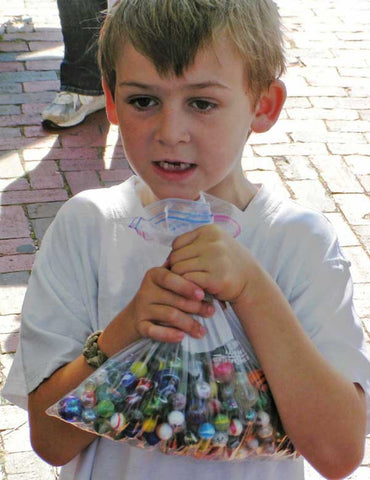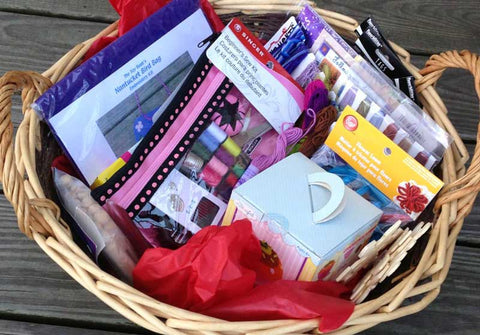 Learning to create is essential to a child's healthy development, and crafts—one of the first ways children create—let them develop several skills at once. Developing strength and coordination in the hands and fingers is a key resource for neurodevelopment. Hand-eye coordination develops fine motor skills, and fine motor skills are essential to writing and reading—and all of these skills can be taught through crafts.
Learning to create is essential to a child's healthy development, and crafts—one of the first ways children create—let them develop several skills at once. Developing strength and coordination in the hands and fingers is a key resource for neurodevelopment. Hand-eye coordination develops fine motor skills, and fine motor skills are essential to writing and reading—and all of these skills can be taught through crafts.
Handwork Enforces Skills
Other skills enforced by handwork are basic eye-tracking and numeracy. Number skills—as you might guess—are essential for all kinds of tasks and crafts. For example, knitting, crocheting, and sewing all require basic numbers-knowledge. Counting how many stitches you cast on. Did you drop any? How far apart are your running stitches? How many running stitches in an inch? All of these questions help build skills that we use every day as adults.
Handwork Teaches Self Reliance
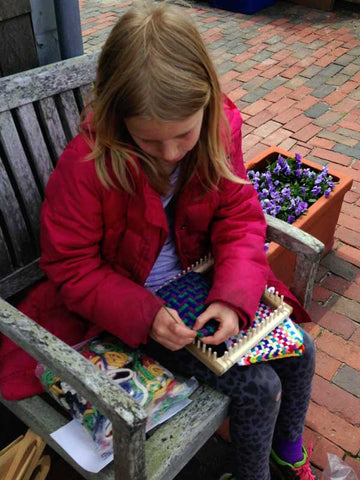 Likewise, crafts can help teach children self reliance. Though self reliance may be a skill that children are slowly losing access to in a world filled with technology, children who do develop self reliance have a number of advantages. If you can mend a hole in your jeans or replace a button on your coat, for example, you can keep using them—and you were able to resolve the problem!
Likewise, crafts can help teach children self reliance. Though self reliance may be a skill that children are slowly losing access to in a world filled with technology, children who do develop self reliance have a number of advantages. If you can mend a hole in your jeans or replace a button on your coat, for example, you can keep using them—and you were able to resolve the problem!
Crafts don't only add to a child's self reliance and mental development, however. Crafts can help children better find their place in the world, providing them an opportunity to develop their generosity and sense of community. Children often share their crafts! Nothing is better than seeing a child's face light up when they give someone a gift that they made. Here at The Toy Boat, we've seen children like Ella find inspiration in our Looper Loom, and go on to weave hundreds of pot-holders for a fundraiser to benefit young women's causes. Our knitting basket inspired Jason to knit scarves for the homeless. And our rock painting directions encouraged Rose to paint rocks for our peace project.
But perhaps the most critical reason to encourage children to work with their hands is that hand-work is central to our history as humans!
Browse our selection of items hand-crafted by family and friends. Whether using our hands to create necessary things or just to make our lives more beautiful, The Toy Boat loves to encourage creativity!
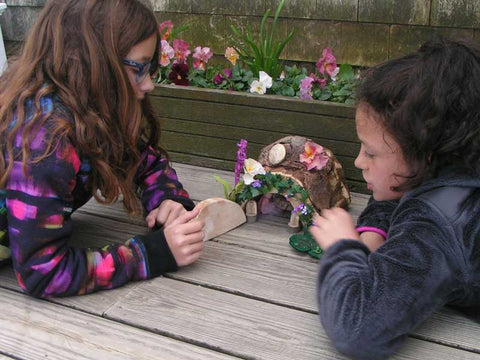 The Toy Boat is a special place, where fairies, mermaids, elves, and dragons live--all waiting for their special person to arrive. When these children find their toy, they're inspired to create a whole new world of magical beasts and beings--elaborate tales of adventure are told, and imaginations overflow!
The Toy Boat is a special place, where fairies, mermaids, elves, and dragons live--all waiting for their special person to arrive. When these children find their toy, they're inspired to create a whole new world of magical beasts and beings--elaborate tales of adventure are told, and imaginations overflow!
The Importance of Magical Play
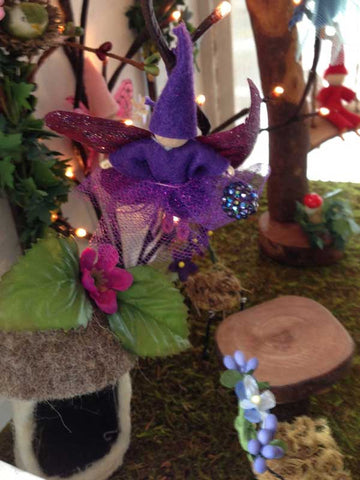 Magical play is evidence of creative thinking. In the magical worlds that they create, children control the environment. The characters they manifest are different from the humans these children know--they're not only accepted for these differences, but elevated because of them. In these worlds, characters can be anything the children want them to be, interacting with one another according to nothing but the child's imagination. Little people live inside acorns, fairies ride on the backs of dragons, and pirates and mermaids are friends.
Magical play is evidence of creative thinking. In the magical worlds that they create, children control the environment. The characters they manifest are different from the humans these children know--they're not only accepted for these differences, but elevated because of them. In these worlds, characters can be anything the children want them to be, interacting with one another according to nothing but the child's imagination. Little people live inside acorns, fairies ride on the backs of dragons, and pirates and mermaids are friends.
During magical, imaginative play, children use abstract and representational thinking. Magical play is the place where a child's ideas are allowed to flourish--it's during this play that real education takes place. Children process their ideas and allow their creative energy to flow during magical play. It's a place where differences are examined, and traditional roles don't exist. Magical play is where children experience creative freedom.
We here at The Toy Boat know that childhood can be a magical time. If you'd like to learn more, visit us and let yourself wander into a world of magic!

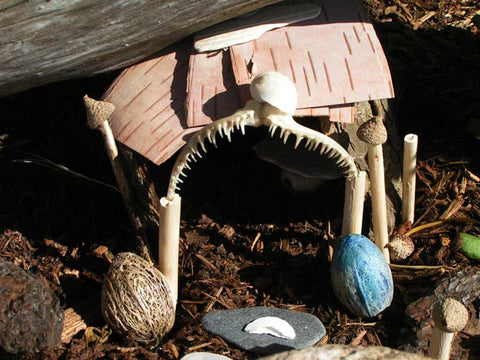 Our 18th annual Enchanted Villages, Fairy House Building
Our 18th annual Enchanted Villages, Fairy House Building
July 21, 3:00 - 4:00
The Toy Boat Fairy Garden
If you've visited The Toy Boat, you've seen our amazing Fairy Garden. Located in front of the store, our Fairy Garden is a wonderful sight, full of tiny houses for fairies, gnomes, and all sorts of other enchanted beings.
These petite dwellings aren't made by tiny, magical hands, however-- they're all made by local children and helpers here at The Toy Boat. Every gnome-home and fairy-house in our garden is made from natural materials, and the layout changes constantly. Walking around our fairy garden, you'll discover tiny hideaways, stairways to the unknown, and tiny doors that could be portals to a tiny hidden world. Here, a fish-jaw creates a doorway, scallop shells become tiny chairs, and old driftwood is transformed into a fairy treehouse. Our garden is a magical place where kids of all ages can experience the wonder of the secret enchantment of Nantucket Island.
Join Us
 You're welcome to come explore our enchanted garden year-round. However, for one magical hour a year, you can join us to contribute to our garden by building your very own fairy home! All materials are provided, and once you're finished, we'll find a special place in our garden for your creation. Feel free to bring along some extra supplies, like natural materials, string, and scissors.
You're welcome to come explore our enchanted garden year-round. However, for one magical hour a year, you can join us to contribute to our garden by building your very own fairy home! All materials are provided, and once you're finished, we'll find a special place in our garden for your creation. Feel free to bring along some extra supplies, like natural materials, string, and scissors.
Oh-- and don't forget, bring your imagination!
A brief history of Marbles
Did you know that marbles have been found in the tombs of the Pharaohs? And that there are references to marbles in Greek and Roman literature? Or that a 15th century manuscript refers to “the little yellow balls with which school boys play, and which were very cheap?”
Marbles have existed in nearly every culture the world over. It shouldn't be surprising, then, that they still hold great appeal to children—their shape, colors, patterns, and textures remain appealing to all ages!
Marbles in America
In the 1930's, America was marble crazy! Every child's pocket had a few marbles in it. School yards and alleyways were full of children knuckle-down in the dirt, and marble contests were all the rage. Marbles were worth their weight in gold to their young owners. All of this popularity held strong until the 1950's, when America's marble madness began to wane.
How Things Changed
Many aspects of America's cultural and physical landscape began to change in the 1950's. Community landscaping began to shift from dirt surfaces to cement or blacktop, including schoolyards and driveways. Alleys became a thing of the past, and suddenly there just wasn't anywhere to play.
Likewise, television lessened the interest in “old fashioned toys.” This, combined with an increase in commercially-produced toys, led to a decrease in interest for marbles. To cut a long story short, as television and commercialism took more control of our lives, marbles fell by the wayside.
The playing of marble games has become almost non-existent. However, marbles have not! They're just the type of timeless toy we here at The Toy Boat believe all children should experience. Games are played, and games are invented for them. We've seen them become jewels and money in fantasy play, and take part in math and science exploration. Their size encourages the development of fine motor skills, and they open dialog between people and offer endless creative possibilities.
Marbles at The Toy Boat
At The Toy Boat, we share the world's fascination with marbles. That's why you'll find an
amazing variety of marbles here! We've got marbles from all over the world— marbles so small they can barely be picked up, marbles so large that we're often asked if they're really marbles at all, and everything in between! We have
hand-made marbles (each one a unique work of art) and
antique marbles to remind us of our history. Stop by the store, and we'll teach you the names of hundreds of marbles—we hope you'll find them as delightful as we do!
There are very few things you can give a six year old that a 60 year old will still love. Here at The Toy Boat, we believe that marbles are one of those things. If you agree, take a look—we've got an excellent
Art Marble section.
The endless variety of sizes and designs that marbles take will never let them be forgotten.
Well, not if we can help it.
 Learning to create is essential to a child's healthy development, and crafts—one of the first ways children create—let them develop several skills at once. Developing strength and coordination in the hands and fingers is a key resource for neurodevelopment. Hand-eye coordination develops fine motor skills, and fine motor skills are essential to writing and reading—and all of these skills can be taught through crafts.
Learning to create is essential to a child's healthy development, and crafts—one of the first ways children create—let them develop several skills at once. Developing strength and coordination in the hands and fingers is a key resource for neurodevelopment. Hand-eye coordination develops fine motor skills, and fine motor skills are essential to writing and reading—and all of these skills can be taught through crafts.  Likewise, crafts can help teach children self reliance. Though self reliance may be a skill that children are slowly losing access to in a world filled with technology, children who do develop self reliance have a number of advantages. If you can mend a hole in your jeans or replace a button on your coat, for example, you can keep using them—and you were able to resolve the problem!
Likewise, crafts can help teach children self reliance. Though self reliance may be a skill that children are slowly losing access to in a world filled with technology, children who do develop self reliance have a number of advantages. If you can mend a hole in your jeans or replace a button on your coat, for example, you can keep using them—and you were able to resolve the problem! 
 Magical play is evidence of creative thinking. In the magical worlds that they create, children control the environment. The characters they manifest are different from the humans these children know--they're not only accepted for these differences, but elevated because of them. In these worlds, characters can be anything the children want them to be, interacting with one another according to nothing but the child's imagination. Little people live inside acorns, fairies ride on the backs of dragons, and pirates and mermaids are friends.
Magical play is evidence of creative thinking. In the magical worlds that they create, children control the environment. The characters they manifest are different from the humans these children know--they're not only accepted for these differences, but elevated because of them. In these worlds, characters can be anything the children want them to be, interacting with one another according to nothing but the child's imagination. Little people live inside acorns, fairies ride on the backs of dragons, and pirates and mermaids are friends.
 Our 18th annual Enchanted Villages, Fairy House Building
Our 18th annual Enchanted Villages, Fairy House Building
